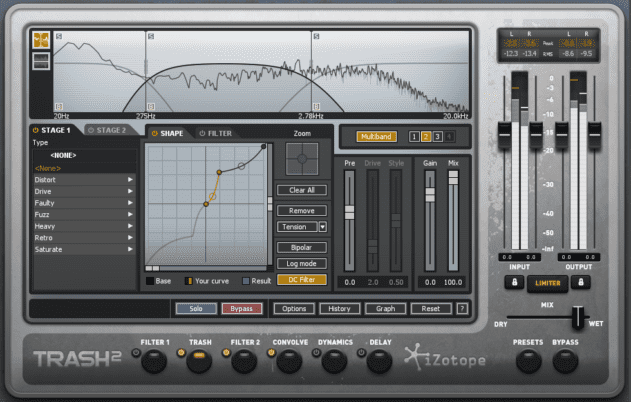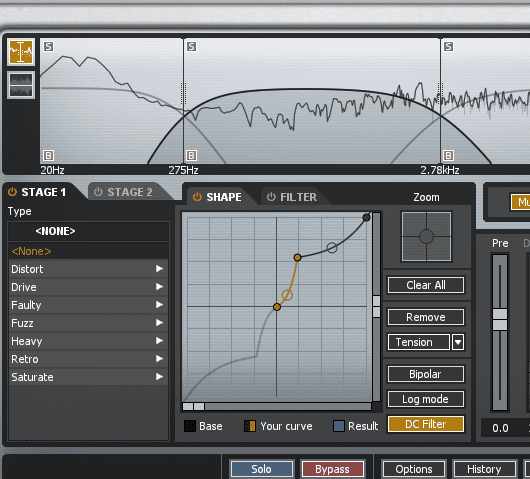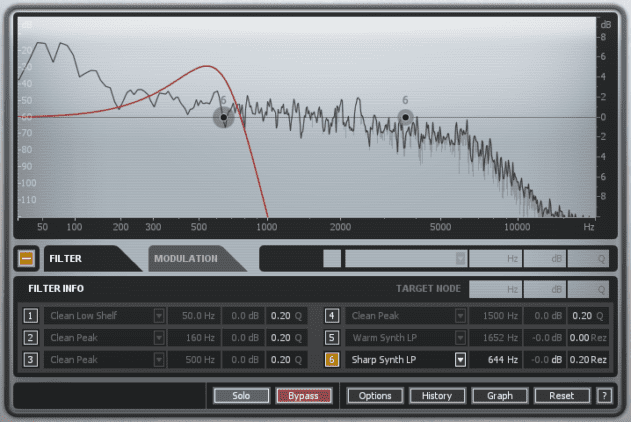Version 1 of iZotope’s Trash lasted ten years without a major update. We put the newly updated distortion plugin to the test.

It’s difficult to believe that iZotope released the original version of its distortion modelling plugin Trash nearly ten years ago. That’s a near-lifetime in the fast-paced world of music software. With such a long time between updates, regular users of both Trash and other iZotope products are eager to find out what additions this update brings.
The most immediately striking difference from the original is the GUI itself, which has had a much-needed update. This time the emphasis is less on making the plugin look like a vintage hardware effect unit and more on providing an aesthetically pleasing mixture of clean lines and muted, metallic colours. More importantly, the layout is clear and logical.
The main navigation buttons located along the bottom of the window provide an easy and accessible way around the stages in the effect chain, switching between tabs for the six effect modules – filter 1, distortion (‘Trash’), filter 2, convolve (which we’ll explain later), dynamics and delay. Being able to bypass individual stages of the chain directly from any tab means it’s quick and easy to decide which combination works best for a given sound.
Furthermore, by selecting ‘Graph’ above the navigation buttons, it’s possible to change the signal flow through the various effects, opening up some really interesting routing options. You can also choose to run effects in parallel, increasing the variety of sounds on offer. We can’t work out how many combinations of different routings this all adds up to, so let’s just say that it’s a lot…
Get dirty
The most obvious place to start is with the distortion stage itself. Trash 2 comes bundled with a huge library of distortion and saturation effects. The distortion is actually split into two stages inside the Trash tab, opening the door to some squashed and brutal sounds. It’s also possible to create multi-band distortion, selecting up to four frequency bands then creating individual distortion effects for each frequency range. Trash’s distortion options are extensive and sound excellent, making it easy to create completely new sounds that are surprisingly useable and exciting.
Trash is nominally a distortion plugin, but at £149 it’s fair to expect a little more versatility. Thankfully the other five stages of the effect chain more than justify the price.
Unlike in the original version, the two filter stages in Trash 2 are now identical, with a variety of different filtering options on offer (up to six simultaneously in each filter stage). Not only are the filters intuitive to use, they’re also powerful, offering everything from subtle lifts and mildly resonant peaks to wild and reckless sounds. Frequencies, gains and Qs are all adjustable via the graphic display. More precise adjustments are possible using the numeric settings in the panel below.
Filter curves can also be modulated, which can provide a great feeling of movement. For example, you can create a resonant peak and set it to sweep between two frequencies, either synced to the DAW’s tempo or controlled by an envelope. The range of envelope follower, auto-wah and autofilter effects which can be created is vast.
For the perfect example of the dramatic difference Trash can make to a sound, take this mild-mannered little Moog Minitaur riff:
And then see what a snarling monster it becomes once it’s fed through a distorted and filtered wah-wah effect in Trash:
Convolution revolution
Trash 2’s Convolve section is the updated version of the Box Model module in the original, allowing convolution effects to be applied. Convolution processing is best known for its use in reverb, modelling the sound of real acoustic spaces, but it’s also possible to model the sound of pieces of equipment based on impulse responses (recordings of their sound when triggered by a known input signal). In this case there’s a large selection of well-known guitar amps on offer. Being able to adjust the type of mic used to ‘record’ the amp is a nice touch which, once again, adds to the infinite variations you can create with Trash. The stereo width slider can also be used to great effect on a variety of instruments. I found it to be especially useful for adding the impression of 3D space to mono pads and vocals.
It’s worth noting, too, that it’s now possible to load your own AIFF or WAV impulse response files, meaning that the Convolve module adds a lot of value to the plugin. If you’re in the market for a basic convolution reverb, this is a selling point in itself.
In the delay module, iZotope have retained the six different effects from the original Trash plug in, but added a host sync option. For me this is the weakest part of the update. Retaining the same six effects from a ten-year-old plugin seems slightly lazy. Even though the sound engines have been updated to bring them into line with the high standards expected of modern iZotope products, more variety here would have been a welcome addition.
Although they’re relatively basic, the compressor/gate and multi-band compression options in the dynamics tab are of a high standard, as you’d expect from iZotope. There’s not a great deal to say here but the real-time graphic display of gain reduction is a useful addition (it’s similar to the one found in FL Studio or the one we’ve seen in previews of Ableton Live 9). Not only is it a handy visualisation of the results when adjusting the dynamic properties of the signal, but it’s also a great tool in understanding the effects of compression.
Conclusion
The price of Trash 2 may seem off-putting at first glance. It’s certainly on the high side for a distortion plugin. But this is a lot more than your average distortion plugin. The range of sounds which can be created using the various modules is virtually infinite. If you consider the price of a good distortion, a good filter and a convolution reverb you’ll probably already be over £149. Treat the dynamics and delay as a bonus…
Many people considered the original to be designed for processing guitars, but don’t let that fool you; this is a plugin which works just as well on synths, drums and loops. A huge range of highly useable sounds are just a few clicks away and a wealth of truly unique, track-defining effects are achievable with just a little more work.
The Verdict
Price: £149
Purchase: iZotope Trash 2
The Final Word
An intuitive and inspiring plugin that can create impressive and original sounds within a few clicks.


01.17 PM
Loved this write up!
Attack killing it with the content.
Thanks for this,
J